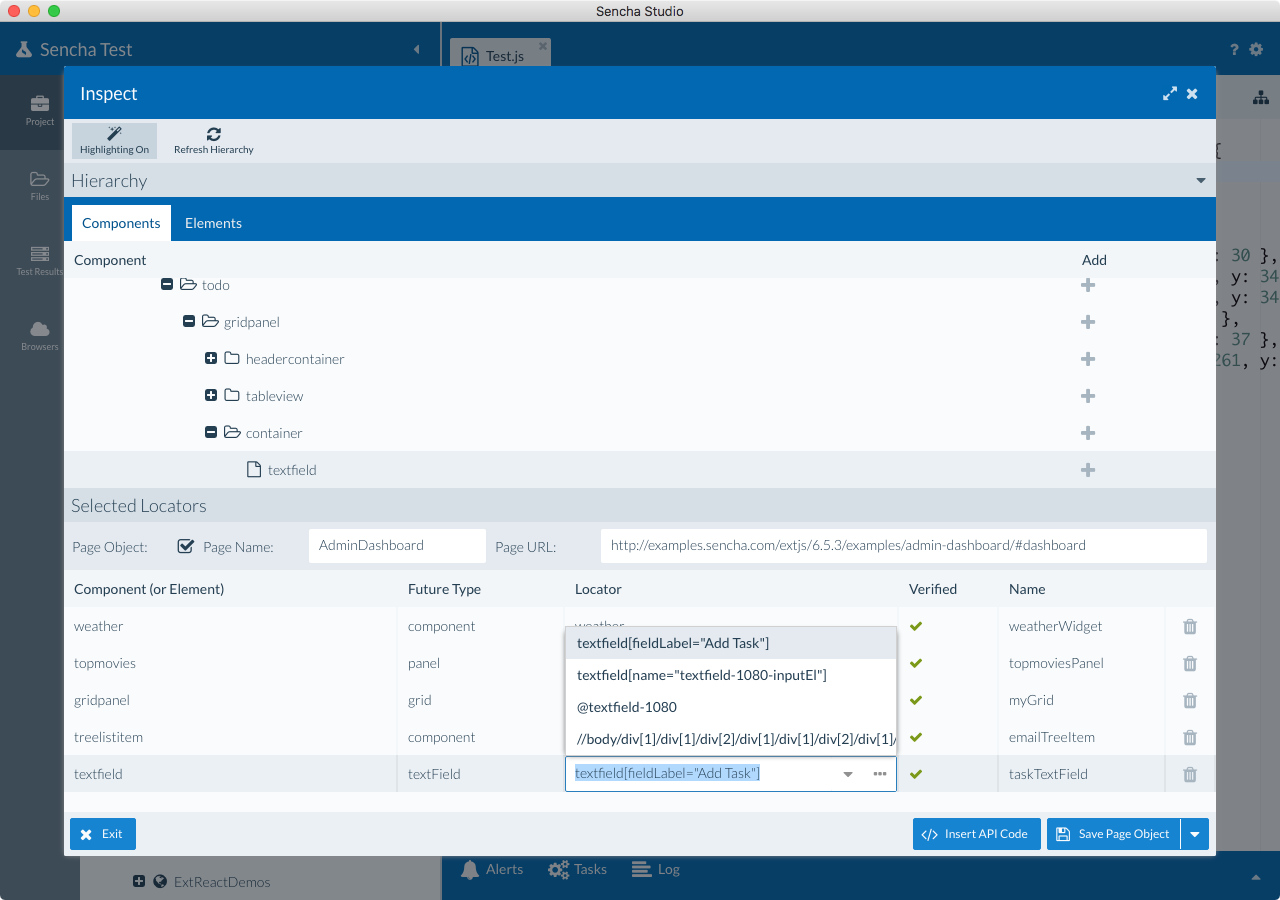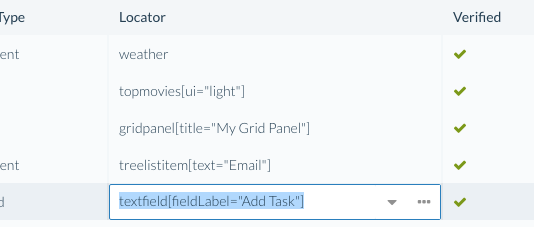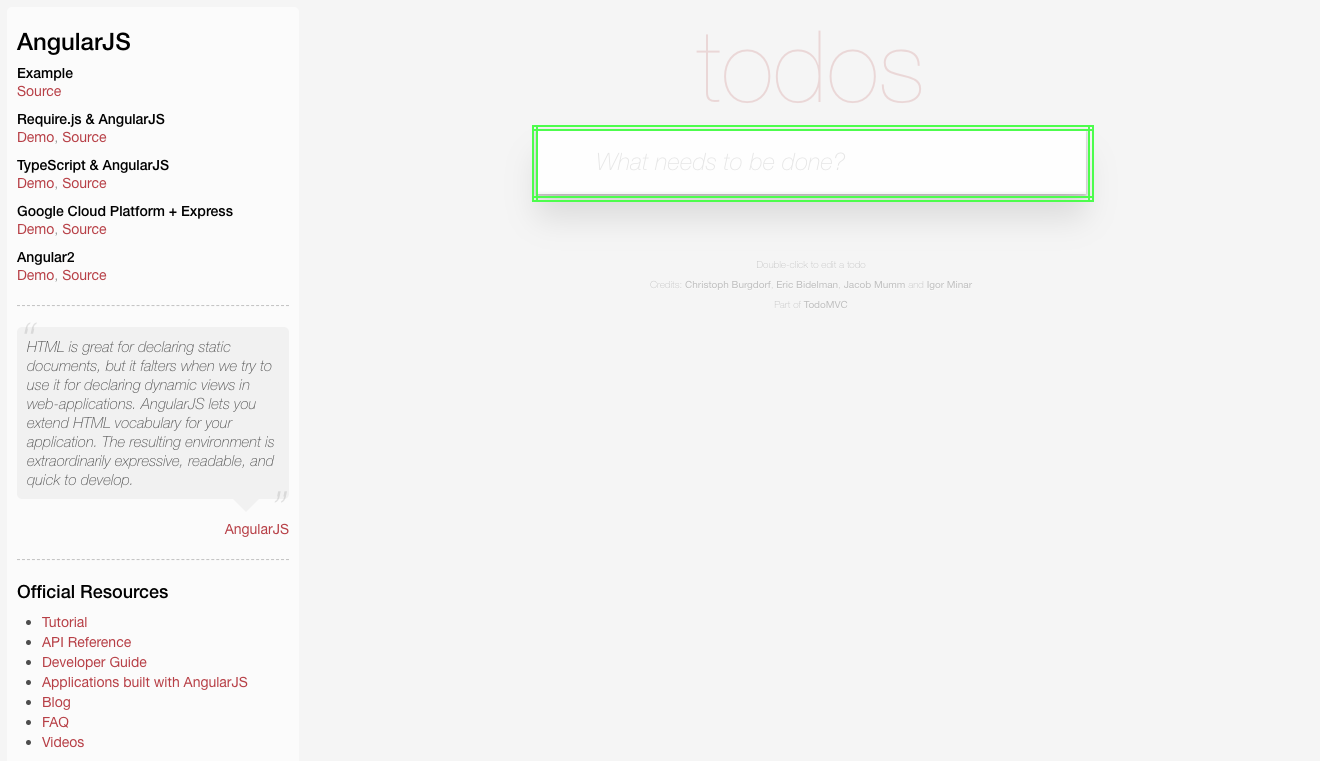Many classes have shortcut names used when creating (instantiating) a class with a
configuration object. The shortcut name is referred to as an alias (or xtype if the
class extends Ext.Component). The alias/xtype is listed next to the class name of
applicable classes for quick reference.
Framework classes or their members may be specified as private or protected. Else,
the class / member is public. Public, protected, and private are access
descriptors used to convey how and when the class or class member should be used.
Public classes and class members are available for use by any other class or application code and may be relied upon as a stable and persistent within major product versions. Public classes and members may safely be extended via a subclass.
Protected class members are stable public members intended to be used by the
owning class or its subclasses. Protected members may safely be extended via a subclass.
Private classes and class members are used internally by the framework and are not intended to be used by application developers. Private classes and members may change or be omitted from the framework at any time without notice and should not be relied upon in application logic.
static label next to the
method name. *See Static below.Below is an example class member that we can disect to show the syntax of a class member (the lookupComponent method as viewed from the Ext.button.Button class in this case).
Let's look at each part of the member row:
lookupComponent in this example)( item ) in this example)Ext.Component in this case). This may be omitted for methods that do not
return anything other than undefined or may display as multiple possible values
separated by a forward slash / signifying that what is returned may depend on the
results of the method call (i.e. a method may return a Component if a get method calls is
successful or false if unsuccessful which would be displayed as
Ext.Component/Boolean).PROTECTED in
this example - see the Flags section below)Ext.container.Container in this example). The source
class will be displayed as a blue link if the member originates from the current class
and gray if it is inherited from an ancestor or mixed-in class.view source in the example)item : Object in the example).undefined a "Returns" section
will note the type of class or object returned and a description (Ext.Component in the
example)Available since 3.4.0 - not pictured in
the example) just after the member descriptionDefaults to: false)The API documentation uses a number of flags to further commnicate the class member's function and intent. The label may be represented by a text label, an abbreviation, or an icon.
classInstance.method1().method2().etc();false is returned from
an event handler- Indicates a framework class
- A singleton framework class. *See the singleton flag for more information
- A component-type framework class (any class within the Ext JS framework that extends Ext.Component)
- Indicates that the class, member, or guide is new in the currently viewed version
- Indicates a class member of type config
- Indicates a class member of type property
- Indicates a class member of type
method
- Indicates a class member of type event
- Indicates a class member of type
theme variable
- Indicates a class member of type
theme mixin
- Indicates that the class, member, or guide is new in the currently viewed version
Just below the class name on an API doc page is a row of buttons corresponding to the types of members owned by the current class. Each button shows a count of members by type (this count is updated as filters are applied). Clicking the button will navigate you to that member section. Hovering over the member-type button will reveal a popup menu of all members of that type for quick navigation.
Getting and setter methods that correlate to a class config option will show up in the methods section as well as in the configs section of both the API doc and the member-type menus just beneath the config they work with. The getter and setter method documentation will be found in the config row for easy reference.
Your page history is kept in localstorage and displayed (using the available real estate) just below the top title bar. By default, the only search results shown are the pages matching the product / version you're currently viewing. You can expand what is displayed by clicking on the button on the right-hand side of the history bar and choosing the "All" radio option. This will show all recent pages in the history bar for all products / versions.
Within the history config menu you will also see a listing of your recent page visits. The results are filtered by the "Current Product / Version" and "All" radio options. Clicking on the button will clear the history bar as well as the history kept in local storage.
If "All" is selected in the history config menu the checkbox option for "Show product details in the history bar" will be enabled. When checked, the product/version for each historic page will show alongside the page name in the history bar. Hovering the cursor over the page names in the history bar will also show the product/version as a tooltip.
Both API docs and guides can be searched for using the search field at the top of the page.
On API doc pages there is also a filter input field that filters the member rows using the filter string. In addition to filtering by string you can filter the class members by access level, inheritance, and read only. This is done using the checkboxes at the top of the page.
The checkbox at the bottom of the API class navigation tree filters the class list to include or exclude private classes.
Clicking on an empty search field will show your last 10 searches for quick navigation.
Each API doc page (with the exception of Javascript primitives pages) has a menu view of metadata relating to that class. This metadata view will have one or more of the following:
Ext.button.Button class has an alternate class name of Ext.Button). Alternate class
names are commonly maintained for backward compatibility.Runnable examples (Fiddles) are expanded on a page by default. You can collapse and expand example code blocks individually using the arrow on the top-left of the code block. You can also toggle the collapse state of all examples using the toggle button on the top-right of the page. The toggle-all state will be remembered between page loads.
Class members are collapsed on a page by default. You can expand and collapse members using the arrow icon on the left of the member row or globally using the expand / collapse all toggle button top-right.
Viewing the docs on narrower screens or browsers will result in a view optimized for a smaller form factor. The primary differences between the desktop and "mobile" view are:
The class source can be viewed by clicking on the class name at the top of an API doc page. The source for class members can be viewed by clicking on the "view source" link on the right-hand side of the member row.
The Inspect tool enables users of Sencha Test to easily locate components and elements in a running web application and create both locator strings as well as Page Objects for accessing those components in tests.
View hierarchy of all components on an Ext JS application page, and a hierarchy of elements on non Ext JS web applications.
Add components from that hierarchy to a list of selected locators.
Hover over the web page in a browser and click to select components/elements. These components/elements are then added to the list of selected locators.
When clicking on hierarchy components/elements or selected locators, Inspect will attempt to highlight the component in the browser with a green rectangle.
Selected locators may be given a page name and individual names and saved as Page
Objects to be used in tests as stpo.<page name>.<locator name>.
A wizard is available to add hierarchical parents to the locator as well as advanced properties as well.
Selected locators can simply be inserted into the current test as ST Futures API expressions. Using the Page Objects feature is not required to make use of Inspect to generate locators.
JavaScript expressions to access Page Objects can be inserted into the current test if Page Objects and named locators are present.
The Inspect tool helps you derive meaningful locators from elements on the web page. If you
consider a simple scenario where you have to enter a value in a text field, you’ll see
the significance of a good locator. For an Ext JS text field on a page, the framework may assign a
default auto-generated id of @textfield-1143. As Ext JS is a highly componentized framework, we
can use a Component Query instead of the id. The Component Query for the text field shown
below is textfield[fieldLabel="Add Task"].

Follow these steps to use the Inspect tool either with an In-Browser (single page application) or WebDriver Scenario (multi page application) test.
Note: A WebDriver scenario needs to be used even if there is just a login page that redirects to a single page Ext JS app.
If you are starting from scratch, have no tests, and already have a deployed application URL, these steps describe how to use the Inspect tool:
Create a new Jasmine Test Suite within your Scenario
Open the newly created Jasmine spec file
Use the pre-made test case should pass.
Place the cursor inside of the it block and launch the Inspect tool by clicking the
Inspect button (search icon).
Select a browser
Wait for the browser to open, application to be loaded and started and for the Inspect grid of the component hierarchy to be presented and filled out.
If the application/URL you configured in the Scenario points to a login page, and you need to inspect the main part of the application, you will need to execute some steps before using Inspect. You can achieve this in two ways:
Add code to your test which navigates to the main part of the app. A common situation is a login page.
describe("test", function() {
it("login then inspect", function() {
ST.element('@email').type('a-username');
ST.element('@password').type('a-password');
ST.element('@submit').click();
// Insert your cursor here, and use the Inspect tool.
// The steps above will be executed before Inspect is used.
});
});
Press Ctrl/Cmd-I to disable inspecting in the browser and proceed to navigate to
the main part of your application.
At this point you should see a component hierarchy in the Inspect window. You can navigate around in this hierarchy.

When you click on a component in the hierarchy you may see the component highlighted in the browser with a bright green rectangle. A message will inform you if a component was highlighted or not. If a component is hidden you will not see it highlighted.

Using the selected value, you can take two different paths here:
ST APIs allow you to create tests targeting Ext JS components and generic elements in web applications. The Inspect tool generates ST API code directly in the editor that can be extended with appropriate API methods based on the test case.
The Inspect Wizard allows users to select more properties to get a one-to-one match with a component or element. The Inspect Wizard can be accessed by clicking in one of the Locator cells in the Selected Locators grid, and clicking the ellipsis icon:

When a locator matches multiple components/elements, additional properties may be needed to narrow down to a specific component/element and this can be done by launching the wizard. Every time a new property is added, the wizard will indicate the number of matching components/elements. The user can save the locator and use it within a test when there is just one match.

The below approach will let you use the Inspect tool to create meaningful locators. We will be enhancing this feature in the future so the page navigation and the URL updates will be captured more effectively.
A page in a single page application can be accessed by just changing the anchor.
For example, in the sample application on Sencha’s website
http://examples.sencha.com/extjs/6.2.0/examples/admin-dashboard/#dashboard -
#dashboard is the anchor.
To inspect the email view, a new spec should be created. In Email.js, insert code that
will navigate the test to the email page, using the ST.navigate API.
Launch the Inspect tool and follow the steps under "Using the Inspect Tool" section to get locators for the new view
Multi page applications that involve page navigation should have code that will login the user and navigate them to the specific page as mentioned above
Once you are on a specific page, launch the Inspect tool and follow the steps under the "Using the Inspect Tool" section to get locators for the new page
Use the DOM tree hierarchy to write tests for HTML elements or pages in the apps that do not have Ext JS components.
Elements can be identified in two different ways:
Create a new Jasmine Test Suite
Open the newly created Jasmine spec file
Use the pre-made test case should pass.
Place the cursor inside of the it block and launch the Inspect tool by clicking the
Inspect button (search icon).
Select a browser
Wait for the browser to open, application to be loaded and started and for the Inspect grid of the component hierarchy to be presented and filled out.
At this point you should see the DOM hierarchy in the Inspect window. You can navigate around in this hierarchy.

When you click on an element in the hierarchy you may see the element highlighted in the browser with a bright green rectangle.

Create a new Jasmine Test Suite
Open the newly created Jasmine spec file
Use the pre-made test case should pass.
Place the cursor inside of the it block and launch the Inspect tool by clicking the
Inspect button (search icon).
Select a browser
Wait for the browser to open, application to be loaded and started and for the Inspect grid of the component hierarchy to be presented and filled out.
At this point you should see the DOM hierarchy in the Inspect window. You can navigate around in this hierarchy.
Instead of identifying elements from the hierarchy, click on elements on the page
The grid in Studio will start displaying the elements clicked on the application with recommended locators
Check if the Verified column has a green check mark and the element on the application has a green rectangle. This means you have a unique locator.
When writing tests for applications, there could be a situation where the pages
either are standard HTML pages or have no Ext JS or ExtReact components. In this situation, the Futures
APIs such as ST.component or ST.grid cannot be used.
We have created the generic API ST.element that will work with any standard element on
the DOM and perform many operations such as click, type etc. Also, the ST.element API
can be used to assert basic verifications such as verify text values in an element.
Similarly, the ST.table API will work with a generic table on a web page that is not an
Ext JS grid. The Table API has specific methods that will allow you to access values
from a cell. Leveraging methods as part of this API will speed up the process of test creation.
More details about these APIs can be found in the API docs.
The Inspect tool in Sencha Test can help in the following ways:
Identify unique locators that are more meaningful and reliable than the IDs
Leverage the Inspect Wizard to add additional properties or change the recommended locator to create a stable strategy
Create Page Objects directly using the identified locators and use the Page Objects to then write tests, thereby keeping the test code concise.